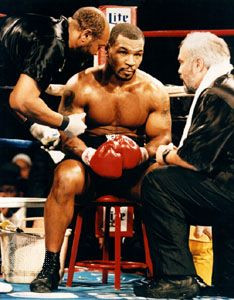Mike Tyson, an iconic figure in the world of boxing, is renowned for his explosive power and controversial persona. But beyond the ring, many are curious about his origins. So, Where Is Mike Tyson From?
Born Michael Gerald Tyson on June 30, 1966, the answer is Brooklyn, New York City, U.S. Specifically, Tyson’s birthplace is Brownsville, a neighborhood in Brooklyn. This gritty urban landscape played a significant role in shaping the early life of the future heavyweight champion.
Image: Mike Tyson, the Brooklyn-born boxing icon, meeting with his trainer Jay Bright during a 1995 fight against Buster Mathis, Jr., showcasing his intense focus and preparation.
Brooklyn Beginnings: The Formative Years of “Iron Mike”
Understanding where Mike Tyson is from is crucial to understanding his journey. Brooklyn in the 1960s and 70s, particularly neighborhoods like Brownsville, presented a challenging environment. Poverty and crime were prevalent, and for a young Michael Tyson, life was marked by instability from an early age. He faced difficulties in school and was involved in petty crime, joining street gangs as a youth.
This tough upbringing in Brooklyn, while challenging, inadvertently set the stage for his boxing career. In 1978, his life took a turn when he was sent to reform school in upstate New York. It was here that his boxing potential was first recognized.
From Reform School to Ring Royalty: Forging a Champion
At the reform school, Tyson’s raw talent and physicality caught the eye of Bobby Stewart, a social worker and boxing enthusiast. Stewart saw beyond Tyson’s troubled exterior and recognized his innate aptitude for boxing. He began training Tyson and, realizing the young man’s exceptional promise, introduced him to the legendary boxing trainer Cus D’Amato.
D’Amato, who would become Tyson’s legal guardian, moved him to Catskill, New York, away from the turbulent environment of Brooklyn. This move was pivotal. D’Amato provided not only expert boxing training but also structure, discipline, and a father figure that had been missing in Tyson’s life. D’Amato instilled in Tyson the “peek-a-boo” style of boxing, characterized by a tight defense and aggressive, bobbing and weaving movements, which would become his signature in the ring.
Under D’Amato’s tutelage, Tyson honed his skills, amassing an impressive amateur record of 24 wins and 3 losses. In 1985, he turned professional, embarking on a meteoric rise through the boxing ranks.
Conquering the Heavyweight Division: Tyson’s Reign
Just a year after turning professional, Mike Tyson, the kid from Brooklyn, achieved the unthinkable. On November 22, 1986, at the age of 20, he knocked out Trevor Berbick in the second round to become the youngest heavyweight champion in boxing history. This victory resonated deeply, not just in the boxing world, but also in Brooklyn and beyond. Tyson’s story became an inspiration, a testament to the possibility of overcoming adversity and achieving greatness, regardless of background.
He unified the heavyweight titles, adding the WBA and IBF belts to his WBC crown by defeating James Smith and Tony Tucker in 1987. Tyson’s dominance was absolute. His explosive knockouts and intimidating presence captivated audiences worldwide. He defended his titles successfully ten times, defeating notable former champions like Larry Holmes and Michael Spinks.
Turbulence and Trials: Life Outside the Ring
Despite his boxing achievements, Tyson’s personal life remained tumultuous. The discipline instilled by D’Amato seemed to wane after the trainer’s death, along with the death of his manager Jimmy Jacobs. Tyson aligned himself with the controversial promoter Don King, and his life became increasingly marred by controversy and legal troubles.
His marriage to actress Robin Givens ended in a messy divorce amid allegations of abuse. In 1992, Tyson was convicted of rape and sentenced to prison, further derailing his career and tarnishing his public image.
Image: A defining moment of controversy in boxing history: Evander Holyfield reacting to Mike Tyson’s bite during their 1997 rematch, an event that shocked the sports world and led to Tyson’s disqualification.
Comebacks and Controversies: The Later Years
After his release from prison in 1995, Tyson attempted a comeback, regaining some of his championship titles. However, his career was further marked by infamous incidents, most notably the 1997 rematch against Evander Holyfield where he bit Holyfield’s ears, leading to his disqualification and suspension of his boxing license.
While Tyson continued to box into the early 2000s, he never fully recaptured his earlier dominance. He faced further legal issues and financial difficulties, eventually declaring bankruptcy despite earning hundreds of millions of dollars during his career.
Beyond Boxing: Tyson’s Enduring Legacy
In retirement, Mike Tyson has remained a public figure. He has embraced his complex legacy, appearing in movies and television, including the popular “Hangover” films and his animated series “Mike Tyson Mysteries.” He has also ventured into business and continues to engage with fans through various platforms.
Despite the controversies and setbacks, Mike Tyson’s impact on boxing and popular culture is undeniable. Knowing where Mike Tyson is from – Brooklyn, New York – provides context to his story. It highlights the journey of a young man from a challenging environment who rose to become a global icon, albeit one with a deeply complicated and often turbulent life. His story serves as a powerful reminder of the influence of origin, circumstance, and the enduring power of human potential, for better or worse.



